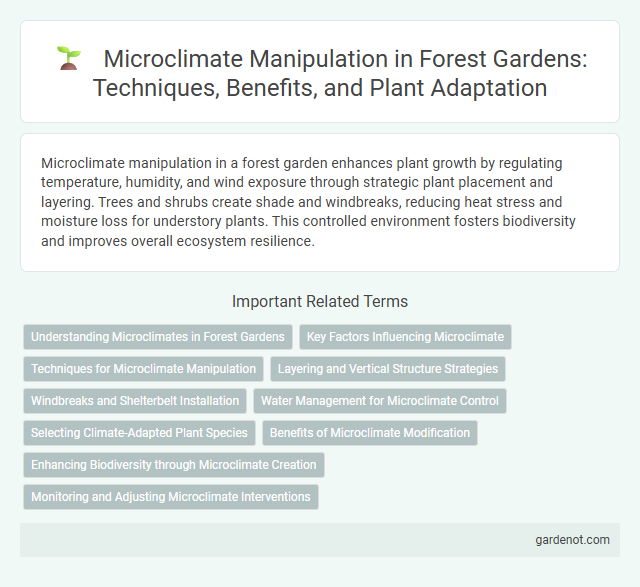Microclimate manipulation in a forest garden enhances plant growth by regulating temperature, humidity, and wind exposure through strategic plant placement and layering. Trees and shrubs create shade and windbreaks, reducing heat stress and moisture loss for understory plants. This controlled environment fosters biodiversity and improves overall ecosystem resilience.
Understanding Microclimates in Forest Gardens
Microclimate manipulation in forest gardens involves strategically shaping local environmental conditions to optimize plant growth and biodiversity. Understanding microclimates requires analyzing factors such as sunlight exposure, wind patterns, soil moisture, and temperature variations within the garden's zones. This knowledge enables gardeners to position species deliberately, enhancing resilience and productivity in the forest garden ecosystem.
Key Factors Influencing Microclimate
Key factors influencing microclimate in forest gardens include canopy structure, soil moisture levels, and wind patterns. Canopy density regulates sunlight penetration and temperature fluctuations, while soil moisture affects humidity and plant health. Windbreaks created by strategically placed trees reduce wind speed, stabilizing the microclimate for optimal plant growth.
Techniques for Microclimate Manipulation
Techniques for microclimate manipulation in forest gardens include strategic planting of windbreaks, mulching to regulate soil moisture and temperature, and creating water features to increase local humidity. Using nitrogen-fixing plants enhances soil fertility while shade-tolerant species reduce heat stress in understory crops. These methods optimize growth conditions, improve biodiversity, and increase resilience against climate variability.
Layering and Vertical Structure Strategies
Layering and vertical structure in forest gardens optimize microclimate by creating diverse canopy heights and plant densities that regulate temperature, humidity, and wind exposure. Utilizing multiple layers--from ground covers and shrubs to tall trees--maximizes light interception and improves soil moisture retention, enhancing plant resilience and productivity. Strategic placement of layers supports biodiversity and microhabitats, fostering a stable ecosystem that thrives under controlled environmental conditions.
Windbreaks and Shelterbelt Installation
Windbreaks and shelterbelt installations play a crucial role in forest garden microclimate manipulation by reducing wind speed and protecting plants from desiccation and physical damage. Strategically planted rows of trees and shrubs create barriers that moderate temperature fluctuations, conserve soil moisture, and enhance humidity levels, promoting healthier plant growth. These natural structures also reduce erosion and provide habitat for beneficial wildlife, contributing to a resilient and productive forest garden ecosystem.
Water Management for Microclimate Control
Water management is crucial for microclimate control in forest gardens, as it regulates soil moisture and ambient humidity, optimizing plant growth and resilience. Techniques such as swales, mulching, and rainwater harvesting enhance water retention and distribution, reducing evaporation and heat stress. Effective water management creates a stable microenvironment that supports diverse plant species and improves overall ecosystem health.
Selecting Climate-Adapted Plant Species
Selecting climate-adapted plant species enhances microclimate manipulation by improving resilience to temperature fluctuations and moisture levels within a forest garden. Species such as drought-tolerant shrubs, shade-providing trees, and native groundcovers create favorable conditions for biodiversity and soil health. Integrating these plants optimizes microclimate stability, promoting sustainable growth and ecosystem balance.
Benefits of Microclimate Modification
Microclimate manipulation in forest gardens enhances temperature regulation, reducing heat stress on plants and extending growing seasons. Improved humidity control supports diverse plant species by maintaining optimal moisture levels, which promotes healthier growth and increased yield. Strategic planting and structural elements create windbreaks that protect crops from damage, boosting overall garden resilience and productivity.
Enhancing Biodiversity through Microclimate Creation
Microclimate manipulation in forest gardens fosters habitat diversity by regulating temperature, humidity, and light exposure, creating niches for varied species. Strategic planting of diverse woody perennials and understory vegetation establishes microhabitats, promoting beneficial insect populations, soil microbes, and pollinators. This targeted environmental engineering enhances biodiversity, supporting ecosystem resilience and productivity.
Monitoring and Adjusting Microclimate Interventions
Continuous monitoring of temperature, humidity, and sunlight levels within a forest garden enables precise microclimate manipulation, promoting optimal plant growth and resilience. Utilizing sensors and environmental data analysis helps identify microclimate variations, guiding targeted interventions such as strategic shading, windbreak installation, and soil moisture regulation. Regular adjustments based on feedback maintain ideal conditions, enhancing biodiversity and maximizing productivity in diverse agroforestry systems.
Microclimate manipulation Infographic

 gardenot.com
gardenot.com